Maker - Kerrywhistles (Phil Hardy) www.kerrywhistles.com
Material - Aluminum and Plastic
Dimensions: Length - 22 13/16ths"
Distance between 1st and 3rd bottom holes - 3"
Diameter of 2nd hole from bottom - 7/16ths"
Bore - 7/8ths"
Weight - 5 oz
Price at time of review - 79 lbs direct from Maker
When
Phil Hardy of Kerrywhistles announced that he had created a new low whistle that would
"revolutionize" the low whistle world, I have to admit I was a bit
skeptical, but certainly also very curious. So when he offered to let
me take one of the very first Optimas made for a test drive for the
purposes of review, I was happy to oblige! While the whistle being
reviewed here is non-tunable, Phil has since decided that he is only
going to sell the Optima as a tunable whistle, so those few who got
their hands on a non-tunable Optima when they were first released may
have a bit of a collectors item on their hands. Phil states that the
Optima will be available in several different keys, and at the time of
this writing was available in Low D, Eb and E. Phil states that he
made the Optima with some very specific ideas/goals in mind, and the
following is a quote from an email he sent out to his emailing list
about his ideas behind the creation of the Optima.
"The primary task of the design was to make a low D whistle that was accessible to all the high D whistler's who found the low Ds too much and also all the female whistlers who cannot make the low D stretch. Volume was also an issue as most low Ds can only be played loud, many people want to play in houses and flats without upsetting others, the Optima has the ability to be played at volume and quietly without losing any tone. The mouthpiece is also designed for comfort, it's small and feels great just like a high D. In these days of belt tightening, price is an issue as well. The Optima at 79 lbs is very affordable and will not break the bank."
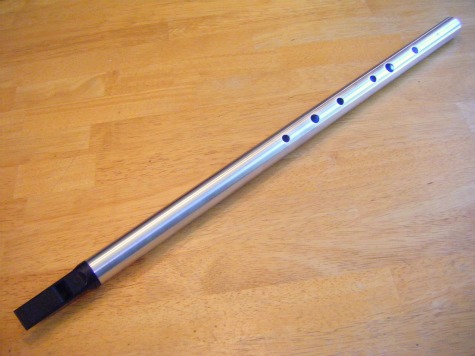
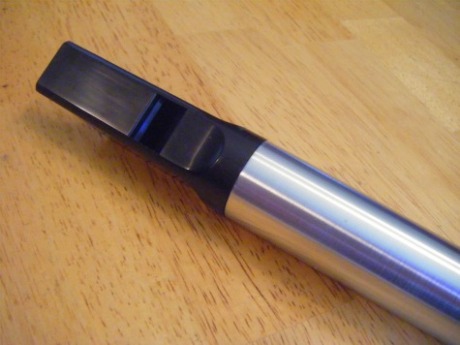
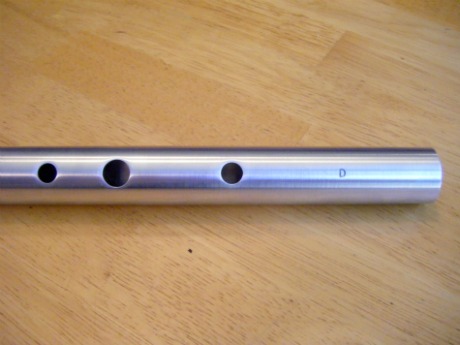
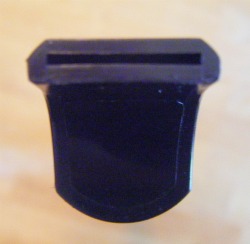
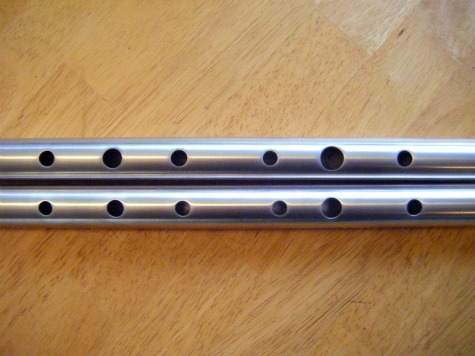
Comparison photo between Chieftain NR (Top) and Kerry Optima (bottom)
"The primary task of the design was to make a low D whistle that was accessible to all the high D whistler's who found the low Ds too much and also all the female whistlers who cannot make the low D stretch. Volume was also an issue as most low Ds can only be played loud, many people want to play in houses and flats without upsetting others, the Optima has the ability to be played at volume and quietly without losing any tone. The mouthpiece is also designed for comfort, it's small and feels great just like a high D. In these days of belt tightening, price is an issue as well. The Optima at 79 lbs is very affordable and will not break the bank."





Comparison photo between Chieftain NR (Top) and Kerry Optima (bottom)
Appearance:The
head of the Optima is basically a plastic version of the Kerry Pro
head, which is of course closely based on the original Overton head
design. It is comfortable on the mouth, and even though I could feel
the ridges of some seams on the underside on my bottom lip, I did not
find it to be annoying or uncomfortable. One of my biggest aesthetic
issues with most plastic head whistles is that the head tends to be
larger than the body, such as on a Howard low whistle. The Optima head,
being as mentioned based on the Overton design, avoids this issue and
looks sleek and streamlined. I like the looks of it in black, which
will be it's standard color, but it will be available in a wide variety
of solid and even clear tinted colors, allowing for a nice touch of
personalization. The head is also nicely molded and smooth with the
slight exception of the aforementioned seams on the underside, with no
left over flashing. The body is the typical polished aluminum, finger
holes were not sharp and the bottom was rounded off. The finger holes
are noticably smaller (see photo comparison above) especially the
second from the top and the second to bottom hole, which tends to be
pretty large on other low D's. The distance from the third to second
bottom holes is much smaller, but this does cause the distance from
bottom and second to bottom holes to be larger. Indeed the distance
between the bottom and third to bottom hole has not changed at all.
Having large hands with long fingers personally, I cannot comment on if
this whistle would be easier to play/reach for people with smaller
hands/fingers, but I did find the smaller holes to make for easier
playing. This whistle was also quite light, coming in two whole ounces
under the average weight of aluminum whistles! This makes for much less
arm fatigue during extended playing (I am not sure how much additional
weight a tuning slide will add, but it can't be that much). All in all
a smart looking and well made whistle.
Tone: I have to say I was really quite surprised and taken by the tone of the Optima. It is not "plastic" sounding at all, and indeed is quite rich. The top end is very pure and sweet while the bottom end has a nice complexity which just hints at it's Overton lineage. It is not overly or too breathy, especially when compared to the Chieftain line, but certainly still has just enough breathiness in it's tone to sound like a whistle, with a goodly amount of chiff. Due to the low breath requirement of the bottom end of the Optima, the low fundamental is not very big. But while I prefer low whistles with large, full, resonant low fundamentals, the richness of the Optimas tone (which is also inherent on it's bottom note) goes a long way to making up for it's lack of fullness and volume.
Volume: I would describe the volume of this whistle as being moderate to quiet. The first octave is most likely quiet due to the light breath required, but as this was a feature that Phil stated he was aiming for on this whistle, one cannot fairly call it an "issue". The very top end is noticably louder than the rest of the whistle, which puts it on the moderate end. While comparatively quieter than any other Kerry Low whistle, it is not as quiet as say, an O'Brien. However it is certainly not a session whistle either, but was not designed to be one. I am not sure if I would say this was a perfect "quiet" practice whistle volume wise, as the top end still carried well.
Backpressure/air requirement:Backpressue on the Optima is moderate with a fairly low air requirement. The transition from the first to the second octave is quite easy and smooth. The top end plays very well, indeed this whistle has the easiest playing third octave D note of all the low D's I have ever played. However the trade off is that the bottom few notes, especially the low fundamental, require a very light breath to keep from breaking. However, this again was something Phil stated he was specifically aiming for in the design of the whistle as he wanted a low D that played more like a high D rather than a typical low D, which tends to require more breath/air.
Responsiveness: While not as responsive/fast as the Chieftain V3, the optima is still nicely responsive, ornaments being crisp, quick and clear. I did notice that some fingerings for octave jumps, like A up to E, would squawk a little if you were not carefull, but this is not as pronounced as on say an Overton or Goldie.
Clogging: The windway on this whistle is extremely thin/narrow as well as being flat, so I was quite surprised to find that I really didn't have any clogging issues with it, most likely due to the head being plastic. Certainly one of the biggest issues with the original Overton head design was clogging, so this is a definate plus for the Optima.
Tuning: This whistle was very well intune with itself, all notes falling within a five cent tolerance range of the rest, even the high A and B, which I have found can be somewhat flat on the Chieftain line of whistles. However this particular whistle was entirely about fifteen to twenty cents flat from A440. This of course would not be an issue with the tunable models, which all Optimas from here on out will be. C natural was good using the standard OXXOOO fingering.
Sound clip: Several videos of Phil Hardy playing the Optima (much better than I could!) can be seen on the Kerrywhistles website here.
Summary: This whistle is almost exactly everything Phil Hardy says it is. I most whole heartedly agree that it is a perfect stepping stone for High whistlers looking to move into low whistles, or even for High whistlers who up until now have not liked the playability and air requirement of low whistles compared to high. It is not a bad beginners whistle, especially when one considers the quality, playability and tone/sound you get for such a low price point, provided that the beginner knew that the Optima is not representive of the playbility and characteristics of most other, typical Low D's. If I had just been handed this whistle without any explanation and asked to review it, I would have given it five holes. But it is my policy that I will not detract from a whistle for features that the maker specifically intended it to have. Where as the only two "issues" I had with this whistle were the touchyness of the air requirement and lack of volume on the bottom notes , both of which were intentional, I'm going to have to say this is a six holer!

Tone: I have to say I was really quite surprised and taken by the tone of the Optima. It is not "plastic" sounding at all, and indeed is quite rich. The top end is very pure and sweet while the bottom end has a nice complexity which just hints at it's Overton lineage. It is not overly or too breathy, especially when compared to the Chieftain line, but certainly still has just enough breathiness in it's tone to sound like a whistle, with a goodly amount of chiff. Due to the low breath requirement of the bottom end of the Optima, the low fundamental is not very big. But while I prefer low whistles with large, full, resonant low fundamentals, the richness of the Optimas tone (which is also inherent on it's bottom note) goes a long way to making up for it's lack of fullness and volume.
Volume: I would describe the volume of this whistle as being moderate to quiet. The first octave is most likely quiet due to the light breath required, but as this was a feature that Phil stated he was aiming for on this whistle, one cannot fairly call it an "issue". The very top end is noticably louder than the rest of the whistle, which puts it on the moderate end. While comparatively quieter than any other Kerry Low whistle, it is not as quiet as say, an O'Brien. However it is certainly not a session whistle either, but was not designed to be one. I am not sure if I would say this was a perfect "quiet" practice whistle volume wise, as the top end still carried well.
Backpressure/air requirement:Backpressue on the Optima is moderate with a fairly low air requirement. The transition from the first to the second octave is quite easy and smooth. The top end plays very well, indeed this whistle has the easiest playing third octave D note of all the low D's I have ever played. However the trade off is that the bottom few notes, especially the low fundamental, require a very light breath to keep from breaking. However, this again was something Phil stated he was specifically aiming for in the design of the whistle as he wanted a low D that played more like a high D rather than a typical low D, which tends to require more breath/air.
Responsiveness: While not as responsive/fast as the Chieftain V3, the optima is still nicely responsive, ornaments being crisp, quick and clear. I did notice that some fingerings for octave jumps, like A up to E, would squawk a little if you were not carefull, but this is not as pronounced as on say an Overton or Goldie.
Clogging: The windway on this whistle is extremely thin/narrow as well as being flat, so I was quite surprised to find that I really didn't have any clogging issues with it, most likely due to the head being plastic. Certainly one of the biggest issues with the original Overton head design was clogging, so this is a definate plus for the Optima.
Tuning: This whistle was very well intune with itself, all notes falling within a five cent tolerance range of the rest, even the high A and B, which I have found can be somewhat flat on the Chieftain line of whistles. However this particular whistle was entirely about fifteen to twenty cents flat from A440. This of course would not be an issue with the tunable models, which all Optimas from here on out will be. C natural was good using the standard OXXOOO fingering.
Sound clip: Several videos of Phil Hardy playing the Optima (much better than I could!) can be seen on the Kerrywhistles website here.
Summary: This whistle is almost exactly everything Phil Hardy says it is. I most whole heartedly agree that it is a perfect stepping stone for High whistlers looking to move into low whistles, or even for High whistlers who up until now have not liked the playability and air requirement of low whistles compared to high. It is not a bad beginners whistle, especially when one considers the quality, playability and tone/sound you get for such a low price point, provided that the beginner knew that the Optima is not representive of the playbility and characteristics of most other, typical Low D's. If I had just been handed this whistle without any explanation and asked to review it, I would have given it five holes. But it is my policy that I will not detract from a whistle for features that the maker specifically intended it to have. Where as the only two "issues" I had with this whistle were the touchyness of the air requirement and lack of volume on the bottom notes , both of which were intentional, I'm going to have to say this is a six holer!